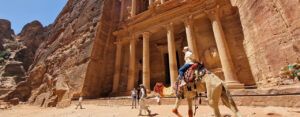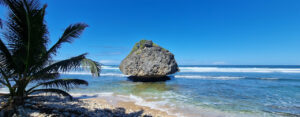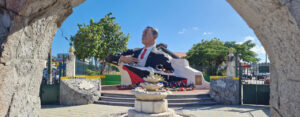
Dominican’t Leave
By the time we reached Dominica—our final new nation of the trip—levels of ‘cruise fatigue’ resulting from too much food, too little sleep, and an endless supply of Heineken were at an all-time high. The epitome of a first-world problem, it may have been, and sympathy certainly isn’t expected, a place that would revive our senses was needed, and Dominica appeared to be the perfect antidote. Known as the “Nature Island of the Caribbean”, it is less about white sand beaches and piña coladas and more about peaks, jungles, waterfalls and rivers—thousands of rivers, apparently, although no one seems to have counted them. From the moment we stepped ashore in the small but bustling capital of Roseau, with the dramatic, green mountains rising straight out of the ocean behind it, it was clear this island was a little different.
We started the day winding up the hills to the Morne Bruce Garrison, a once-formidable British military site now mostly reduced to an informative sign, a flagpole, and a few benches neglected by the parks department. The view, though, was exceptional. From that height, you could see all of Roseau sprawled below—its patchwork of low-rise buildings, red roofs, and the unmistakable hulking presence of our cruise ship monstrosity squatting at the dock like a floating Butlin’s. The signboard cheerfully described the fort’s strategic significance during various colonial skirmishes, though much of the former stronghold has long been lost to time.
A short drive inland brought us to a forest trail that led to one of the island’s many waterfalls. The trail was blessedly short and shaded, the air thick with the smells of damp rock and crushed greenery where everything dripped, slithered, or buzzed ominously. Emerging into a grotto of volcanic cliffs and plunging cold water, we found the cascade tumbling into a deep, clear pool. One of us swam, no prizes for guessing which. The other observed from the rocks and looked after the bags, a vital and necessary task, nonetheless. Still, it was an idyllic spot, a setting that almost made us forget we were “cruisers”, wearing our ship access wristbands like tagged cattle.
The next stop was a traditional Kalinago cultural centre, set among lush foliage and neatly arranged huts woven from palm leaves. The Kalinago are the indigenous people of Dominica, and this particular community has preserved and revived elements of their heritage for educational visits. It could have felt awkward and extremely gimmicky, but fortunately, it didn’t… much. We were greeted with music—deep drums and shakers made from seeds—and invited to sit for a performance that was equal parts history lesson and dance class. The men drummed, the women danced, and then—inevitably—some were dragged up to join (unless you’re Lowri, in which case you’re first to volunteer). It turns out that while the Kalinago have kept their rhythm, most cruise passengers, myself included, absolutely have not. Still, we all clapped and swayed with the kind of clumsiness usually reserved for the first dance at weddings.
Lunch was served under a wide shelter in the forest, long wooden tables set with cheerful tablecloths which seemed to attract the resident populace of yellow-bellied bananaquits. The food was simple and superb: rice and peas, callaloo, local vegetables, and fresh passionfruit juice. Around us, vines hung lazily from branches, and the jungle made itself heard with clicks, rustles, and the occasional indifferent meow from a passing cat. However, we couldn’t linger all afternoon as we had a coast to drive. The east coast of Dominica, to be exact, which is equal parts beautiful and petrifying. The road precariously clings to the edge of the island, winding through hairpin turns and opening up to dramatic cliffs and jungle-soaked valleys. We passed fruit stalls, goats on improbable ledges, and a boy selling coconuts next to what might have been an active landslide. The views were relentless.
We ended the day at Ruins Rock Café in Roseau, a bar inside a partially collapsed stone building, which was both very atmospheric and a structural health risk. A gorilla statue guarded the door, unsure as to why, while inside, flags from every corner of the globe hung like laundry, and improbably, a giant Welsh dragon greeted us overhead. Clearly, we weren’t the first from Cymru to find refuge here. The rum punch claimed to be the best on the island, and after several sips feigning expertise, we agreed with the bar staff. As we wandered back to the ship, we concluded that the green and impressive nation of Dominica was exactly the jolt we needed. Just one last stop awaited us—a return to Barbados, where it all started, for a final familiar taste of rum, relaxation, and Rihanna.
J























Yet another gem of a story.